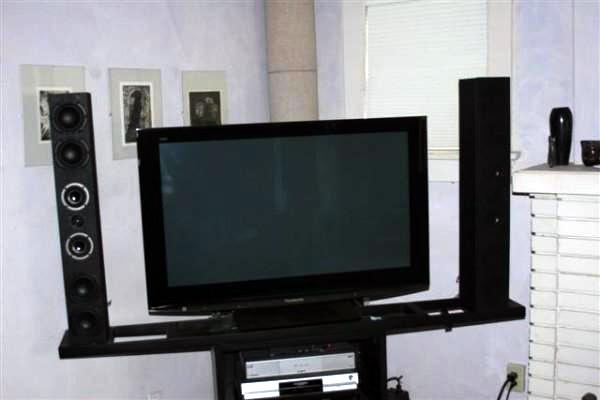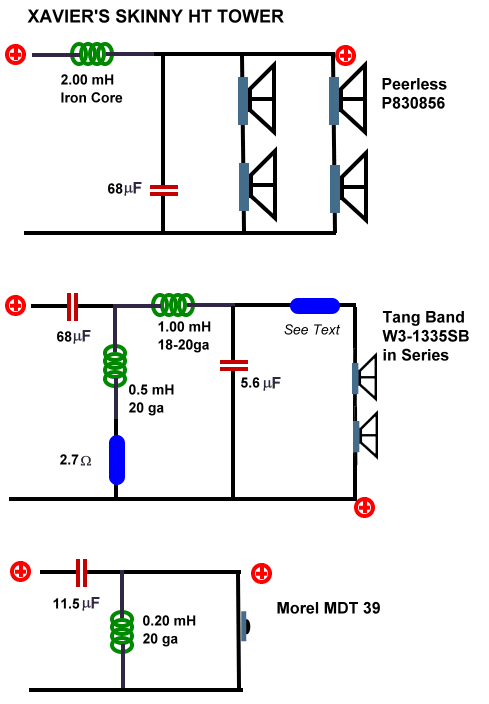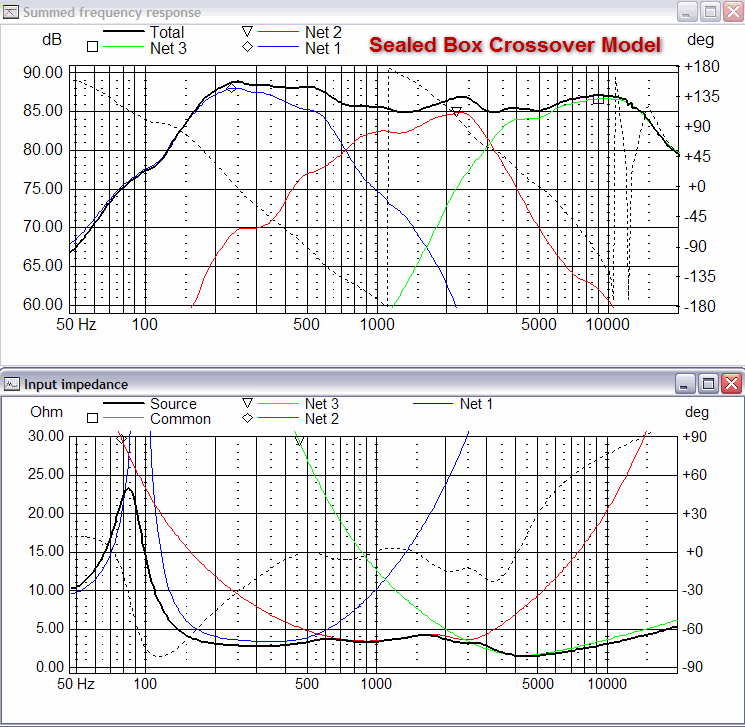| Last Update: June 15, 2009 | Xavier's Slimline HT Tower | Xavier's page |

 |
Woofers: Four Peerless 830856 in two 3.3 liter chambers vented with two 1"D X 4" L ports per chamber. Series wired within chamber, two chambers wired in parallel Estimated F3 = 82 Hz |
|
 |
Midrange: Two Tang Band W3-1335SB 3" Titanium Cone Wired in series. Sealed 1.5 liter chamber |
|
 |
Tweeter: Morel MDT39 | Click here for an alternative CHEAP tweeter design |
| Basic Design | FOR MEASUREMENTS PAGE CLICK HERE |
Xavier is one of those genuine audiophiles who enjoys tweaking and trading out. He also prefers shallow roll of slopes and series crossovers for "serious" listening. He decided to upgrade his TV from an HD tube to a flat screen. With limited room, he wanted thinner L/R to better fit the space available. (no center channel either) He liked the X158MTM we built for DVD's but found them a bit harsh on a lot of commercial channels. (As if Billy Mays isn't irritating enough...) No doubt -- there is very little consistency in audio quality across channels. So polite makes sense to me especially in a bright small room.
He wanted to try out the 3" Tang Band mids. When the Peerless hit the buyout bins at Parts Express we got together and bought a case. He selected the Morel MDT39 for a small faceplate tweeter. (Although I thought the MDT39 may not have enough sensitivity -- it turned out to be a challenge but workable.) The Peerless needs about a 3.75" hole just to clear the shield cup with wires attached. So we went with 4" inside width and 1/2" Baltic for construction.
The Tang bands would be very happy in 0.5 liters sealed. So the mid chamber only need to be deep enough to clear the mids & tweeter + a bit of damping material. After laying out the drivers we agreed on inside dimensions of 2" X 11". This nets about 1.5 liters. The rest of the box behind the mid chamber was left open for the crossover.
I designed the initial box for running the Peerless sealed. But based on the prototype the F3 was about 120 and just crossed too high to integrate well into the subs. So we added another 3/4" to the box and found just enough room to install a pair of 1" ports on the rear of the box between the woofers. The resulting inside box dimensions are now 4" X 4.75". Each of the woofer chambers is separate has an estimated 3.3 liters of net volume and is tuned to 83Hz. With the receiver set on small, this ought to give plenty of overlap.
Crossover
Xavier insisted "we always wind up padding down the tweeter". True Dat. So I set out in hopes I could get everything down to the sensitivity of the morel. We wired the Tang bands in series to cut their sensitivity and up their power handling. I opted for what I call a "single point" measurement. We set the bottom of the box up 22" off the ground. I positioned the microphone about 1 meter away at tweeter height, just slightly off axis. We measured the tweeter, both tang bands, and all four peerless as single "drivers" without changing microphone positions. In LspCad I give all drivers the same X & Y, but adjust the depth of acoustic centers as discussed on my "How I Measure" page. It gives up some of the off axis response plots, but minimizes time. It also makes model phase alignment a complete SWAG. If it didn't work out, we'd just measure again...
I wound up with a fairly simple 2nd order electrical everywhere. Clearly a 4 Ohm speaker, with crossovers at 550 & 3500. The woofers could easily handle 2000. The Tang bands really look like a "full range" speaker. (+300 and up). I REALLY liked these little buggers. Clean and clear. If you needed a nice little mid to match up with a tiny neo tweet, I'd give these a try. For covering about the same bandwidth, I'd take them over the RS52 dome in a heartbeat.
I ran through a couple of prototypes but could never get great looking phase alignment between tweeter and mid. Nor could I get the edge diffraction to go away. So I got the response curve as flat as I could, and set up a prototype crossover. In my garage, it sounded dark and forward. But Xavier took it home, ran it with his HK receiver & dish feed. He came back with 5ohms of padding on the mids (the "see text" reference on the diagram) Back in the shop, with the new ported box, I liked it flat (unpadded). Fortunately you need a lot of resistor to make the change significant. You can see the With & Without prototypes on the Measurement PageAdding padding to the mid's is not particularly sensitive. 2-3 ohms will only drop them about 1 db. ( This also reenforces my ongoing contention that taste, room acoustics, and the amplification change all significantly affect what you hear )
I'll wait for Xavier to critique the final product. I thought the ported prototype sounded very balanced, neutral, and maybe a little dark on the top end. Nice job on vocals, a wee bit forward for intelligible dialog.
12 July 2009 Update
Turns out one of the Morel's wasn't working right. After Xavier ran them for awhile he decided he liked the mids padded down with 5 ohms. He'll also work with the tweeter to add 1-2 ohms padding on the Morels. I thought they sounded about right in my garage with no padding. But I think we may have been listening to the "weak" tweeter, and at full range. Xavier said that the twin 1" ports would "howl like a dog" at full range. He uses a 100 Hz cut off on his HK home theater receiver and the ports remain well behaved.
Once we got the boxes built, we had to live with the basic geometry. If I were to build these again, I would consider slot ports or venting the Peerless into the space behind the mid chamber.
| Box Layout with 1/2" Baltic Birch  |
 |
